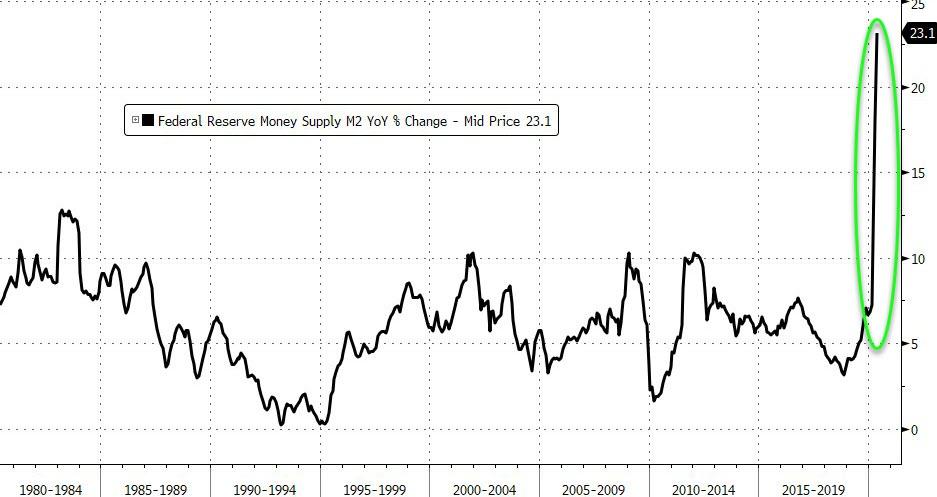Markets Have Jumped The Shark
Tyler Durden
Thu, 07/02/2020 – 08:52
Welcome to the Twilight Zone. Nothing seems real anymore — not the economy, not the markets, not the politics — and it is increasingly difficult to distinguish the difference between what is and what isn’t. It truly feels the economy, markets, and the U.S. political system are in a period of suspended animation.
S&P500 to 4,000 On Money Supply Expansion
Larry Lindsey, the former director of the National Economic Council, under President Bush #43, came out on CNBC this morning making a market call of an S&P500 at 4,000, based solely on the expansion of the money supply via the Fed balance sheet.
Here’s a snippet,
“…I just did some math on what is happening to the money supply…when you have a rapid expansion of the Fed’s balance sheet that the main effect is on asset prices….so I simply do the extrapolation…of what might be expected to happen in stock prices.” – Lawrence Lindsey
The great Kelly Evans then jumps in putting a date on the 4,000 S&P target at year-end 2021.
There you have it, folks, a forecast of the creation of more than $7 trillion of wealth over the next 18 months based, not on productivity gains, innovation, nor economic growth, but by keeping the digital printing press running.
Whether the wealth is real at the end of 2021 will depend on the purchasing power of the dollar, which we suspect will be lower than most currently expect.
The New Henry Kauffman?
Lindsey’s call hearkens back to the days of Solomon Brothers’ economist and market guru, Henry Kaufman, using his money supply forecasts to predict interest rates,
The job of restraining money supply growth ”will be more difficult and involve a greater degree of monetary restraint and adverse development for interest rates than is now envisioned by the authorities,” Mr. Kaufman said. – NY Times, July 23, 1982
Nothing but Happy Days ahead as long as we keep the press that prints the digital money rolling. Just remember, folks, it was when the Fonz “jumped the shark” that ended Happy Days.
M2 Money Supply Growth
Does the following chart of the monthly year-on-year growth of the M2 money supply look normal, stable, or sustainable? That, folks, is what Larry Lindsey and many of today’s “market gurus” and talking heads are using to rationalize the rally in risk assets.
What Is Money?
Fair enough. But economists can’t even agree on what defines money, how it should be measured, and what should be included in the monetary aggregates. Should brokerage accounts, for example, where you can lever up on gold ETFS and still write checks on the account be considered part of the money supply?
During my graduate school days when monetarism was in crisis as the relationship between the money supply figures and GDP started to unravel, the Fed even toyed, or at least, researched the possibility of including equity mutual funds in the money supply figures.
Why This QE Is Different From The Past
The increase of the money supply via the Fed, rather than bank credit expansion, though more stable, is potentially much more inflationary. During the Great Financial Crisis (GFC) and, shortly thereafter, the financial system was impaired and credit — which also creates money — was contracting and the Fed moved quickly to offset the shrinkage of endogenous money.
No credit crunch during the COVID crisis, however, as the Fed has backstopped, or announced to the world it would, almost anything and everything. Credit is flowing just about as freely as the Mississippi River during storm season.
By the way, the CEO of a major restaurant chain called for the US government to backstop all restaurants’ rent payments on CNBC today. Just wow, and how do you think that would be financed? Unfunded pension plans are most likely next and it won’t stop there.
As a good friend of mine recently wrote, “Here Come The Crony Capitalists.”
We are so far down this rabbit hole there is no returning.
Donut Shop Analogy
The Fed is adding more liquidity into the system at a zero percent IOER largely by removing financial assets from the same system and replacing them with reserves or cash equivalent balances. These reserves can then be used to create additional credit or even more money. We won’t get into it here but why would banks keep excess reserves that now earn zero or close to zero percent on their balance sheets?
The Fed is also indirectly financing the USG’s budget deficits, which include direct cash grant payments to American households. No doubt much of this is needed and the right thing to do, in our opinion, but we can think of better ways to do it. The timing and necessity of speed probably left no better alternatives.
If the next government doesn’t embark on a series of strong structural reforms, then we are really…you know, rhymes with shucks.
The Local Donut Shop And Financial Asset Inflation
Imagine your local donut shop, which is very busy on Saturday mornings with lines running around the block. The donut shop serves only chocolate and maple donuts. The chocolate donuts represent financial assets and the maple represent real goods and services.
The people in line, many of which already own several chocolate donuts, have certain preferences for chocolate versus maple donuts.
Before opening, a Brinks Truck pulls up and buys up half the chocolate donuts in the shop and those held by the customers standing line. In addition, they hand out an additional $100 to everyone standing in the line that can only be spent in the donut shop.
Take a guess at what’s going to happen to the price of chocolate donuts when the shop opens?
The Fed, the Brinks Truck, has created a demand and supply shock for chocolate donuts or financial assets. A positive demand shock by handing out cash and injecting more liquidity through its purchases. A negative supply shock by removing chocolate donuts or financial assets from the donut shop and those of the customers in line.
All good until the price of maple donuts begins to rise, especially if some are imported from Canada with a now weaker currency, as the mandate of Brinks company is to maintain a stable price and production of maple donuts.
A crude analogy, which we wouldn’t try to defend in front of a dissertation committee but it paints a pretty good picture of what, we believe, is driving asset markets. This new supply-side economics has been going on for years but now it’s overdosing on steroids.
The End Game
We don’t how this all this ends but imagine the owners of the donut shop, which employs most of the customers in line and has made a killing but is now very dependent on the Brinks Truck showing up every Saturday morning. The owners have used the easy money policy of Brinks to help finance a very lavish lifestyle and have borrowed money to expand production.
The Brinks company sees the price of maple donuts rising. Can they now pull back and stop showing up on Saturday morning without collapsing the donut shop? We don’t think so.
Infinite money demand or the notion velocity remaining an asymptotic function approaching zero is not a forever game. The risk is increasing it’s closer to the ninth inning than the first. What is truly alarming is that monetary policy is such a black box that nobody knows, including Jerome Powell and the rest of the monetary authorities.
Gold, baby.
via ZeroHedge News https://ift.tt/3gl29BQ Tyler Durden

